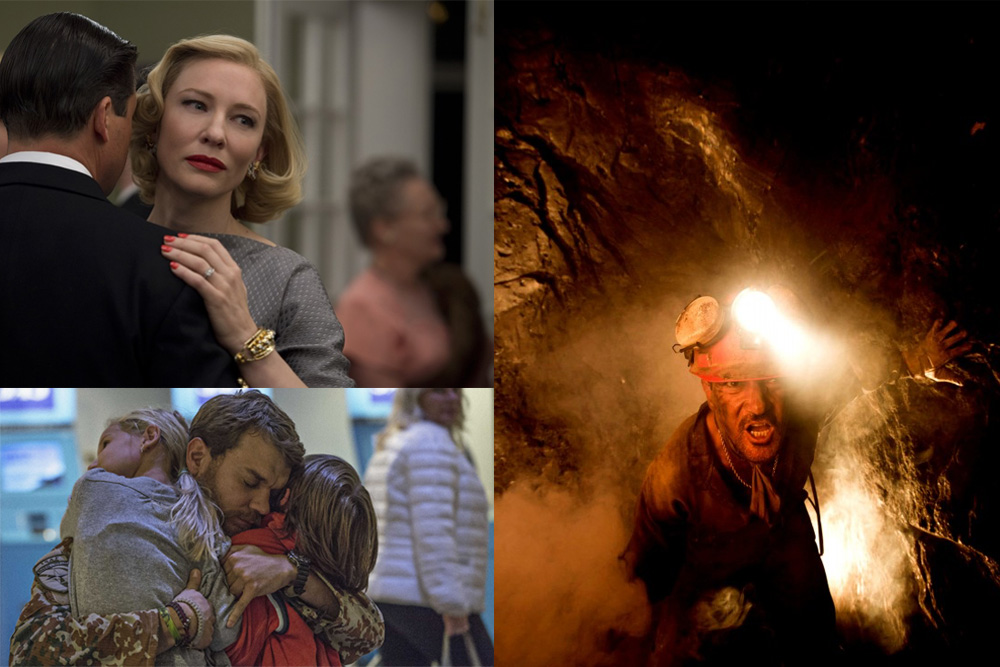AFI Fest Day Five: Climaxes of ‘Carol,’ ‘A War’ deliver well, while ‘The 33’ falls flat

Day five at AFI Fest saw the brilliant climaxes of “Carol” (top left) and “A War” (bottom left), while the ending “The 33” (right) falls flat. (Film4 Productions, AZ Celtic Films and Warner Bros. Pictures)
By Sebastian Torrelio
Nov. 10, 2015 3:27 p.m.
The climax in movies is a beautiful thing. If a film can funnel the intricacies of its plot into one moment of breathtaking resolution, it makes the viewer’s experience more rewarding.
This year, AFI Fest has had an abundance of movies that build up to one significant scene which have, for the most part, worked out for the better.
Two films in particular have exemplified how the workings of the pulse-pounding climax should work, whereas another notable piece fell a bit flat in that regard.
It wouldn’t be unwarranted to say the most widely anticipated film at AFI Fest this year was “Carol,” Todd Haynes’ romantic tale of Carol Aird (Cate Blanchett) and Therese Belivet (Rooney Mara).
Carol, in a loveless marriage that she plans to get out of, negotiates with her husband Harge (Kyle Chandler) how they should manage their time for their daughter. Meanwhile, Therese works dispassionately at a department store in the middle of the Christmas rush, also in a relationship she is disinterested in.
“Carol” works with a sense of unknowingness, as Carol and Therese meet on screen, unsure of how to approach their feelings for one another. Under the 1950s backdrop of glistening snow and holiday music, their building relationship is always present on screen, but managed with the most delicate of touches.
Unbeknownst to the audience until the moment the pin drops, “Carol” masterfully weaves the two characters together and caps it off with a crescendo so brilliant, it demands attention. “Carol” is framed exquisitely as a conflict of suppressed desires that, even when let loose, only come out as muted wisps of a forbidden love.
On the other side of the spectrum, “A War” is, quite literally, a war film. However, it has a tamed side that comes up unexpectedly. Claus Michael Pedersen (Pilou Asbæk) and his army troop are stationed in the civilian province of Helmand, Afghanistan. While seeking out the Taliban, they see unrelenting violence on a daily basis, being in one of the most hostile environments on Earth. When Claus and his men come under heavy fire, he must make a swift decision that protects the lives of his company.
The interesting thing about “A War” is that its grand climax comes near the end of the film, once Claus is at the mercy of a nerve-wracking decision of a different nature.
Director Tobias Lindholm takes consideration of the circumstances in which soldiers live, careful not to take advantage of their mindsets or personal sanctity, but to display the realisms of forced life and death scenarios. Probing dark questions with an elegant simplicity, “A War” is a film that treads lightly over its subjects, smart enough to treat them as humans surrounded by an inhumane hostility.
“A War” demonstrates a far better execution of the dramatic humans in danger scenario than “The 33,” which had its Los Angeles premier at the festival Monday. Patricia Riggen directs the harrowing account of 33 Chilean miners who were trapped underground for over two months in 2010, resulting in international attention. Unsurprisingly, the whole film builds up to their moment of climactic rescue.
Watching “The 33” at AFI Fest is difficult. Unlike so many independent, foreign-language pieces at the festival which honestly express feelings and ideas, “The 33” is created under the blueprint of Hollywood blockbuster logistics.
Antonio Banderas and Lou Diamond Phillips, who star as two of the miners with leadership roles, only speak in loud, confrontational remarks about their predicament. Rarely, if at all, does “The 33” have a humanizing moment. No scene turns attention away from the historical account to look into why these working class men’s psychology and treatment is strikingly full of despair. The big ending, therefore, comes across much less as inspiring, and much more as perfunctory.
“The 33,” with a cast full of fun personalities that keep it moderately entertaining, does well to honor the men and their families involved one of the more memorable, hopeful news stories this decade. But it would be hard to call it inspiring when films such as “Carol” and “A War,” which speak such higher truths, are being shown alongside.
Compiled by Sebastian Torrelio, A&E senior staff.


